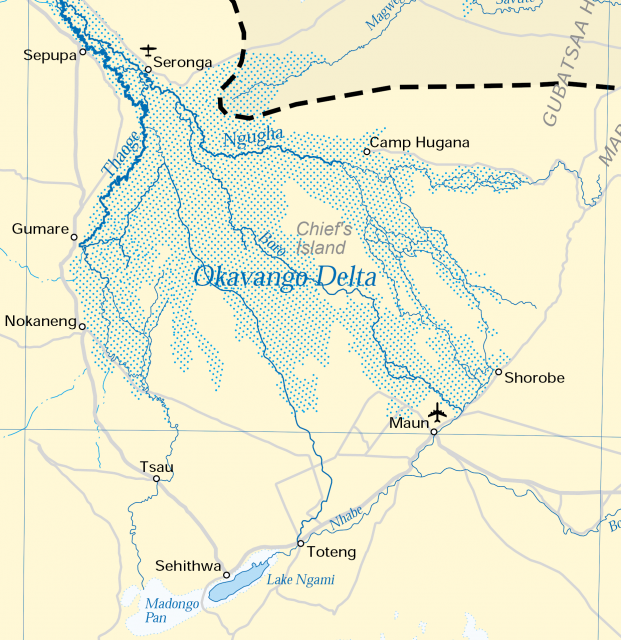Okavango
COVERING AN AREA roughly the size of CONNECTICUT, Okavango is the largest inland DELTA in the world. It is located in north-central BOTSWANA in the middle of the KALAHARI DESERT and is formed by the Cubango and Cuito rivers flowing out of mountains in ANGOLA and into the Okavango River.
Okavango covers a swampy depression that was once a prehistoric lake. The northern part of the swamp is always wet with lots of papyrus growing in it and covers about 2,320 square mi (6,000 square km) of the Okavango area. A small shelf of sediment about 16 ft (5 m) high from the Kalahari confines the delta here. The southern part of Okavango fills seasonally during the rains and covers another 2,700 square mi (7,000 sq km) and up to 4,630 square mi (12,000 sq km) depending on how much rainfall they get each year. In this area the delta branches out into three main channels: the Thaoge to the west, the Jao/Boro in the center, and the Nqoga/Maunachira to the east. Average water depth in the swamps of Okavango are about 5 ft (1.6 m). Much of this area is also covered in vegetation that grows profusely due to the rich silt constantly being brought in by the Cubango and Cuito Rivers. These rivers bring a flood of water during the rainy season peaking in March or April. The water is really a blessing to this area since otherwise the delta would only get about 19 in (50 cm) of rain per year. It would have turned into part of the Kalahari Desert long ago were in not for the water flowing into the area. Only 2 percent of water in Okavango actually flows out of the delta area via the Boteti River. This is due to the huge amount of evaporation that occurs in this area. More than 72 in (180 cm) of water evaporate each year because of the average daily temperatures of 86.7 degrees F (30.4 degrees C) in Okavango. The papyrus is well adapted to this type of climate and is one of the fastest growing plants on Earth. It has spread throughout Okavango, sending seeds downstream to become new plants. Papyrus forms beds, which become their own islands in the swamps of Okavango, towering overhead like a jungle.

The upper region of Okavango that is permanent swamp is often called the Panhandle portion of the delta. The region below this is a broad and slightly fanlike area with a gentle slope to it. At the edge of this fan area, there are two major depressions: the Mababe Depression in the east and Lake Ngami, which is currently dry, in the west. In response to the amount of silt in the area, the dense vegetation, shifting of the Earth's crust, and the constantly moving water, over time Okavango's delta has changed shape. Both of these areas contained actual lakes in the past and are now wide grassy areas with rich soil where the Damara people of the region herd sheep and cattle.
Okavango is an extension of the East African Rift System of faults. Two parallel fault lines in the Panhandle confine the upper portion of the delta where the Okavango River enters the Kalahari Basin. The Thamalakane and Kunyere faults define the southeast limit of the delta. At 125 mi (200 km) long, the Thamalakane fault acts like a natural dam from which the Boteti River flows out of the delta. The parallel Gomare fault, a continuation of the Great Rift Valley of eastern Africa, runs southwest to northeast at the southern end of the Panhandle.
After passing through this fault, the swamps then branch out in the alluvial fan formation of the rest of Okavango's delta. The rift between the Gomare and Thamalakane faults is what is believed to have originally formed the geographical basis for the Okavango delta of today. This whole area supports a wide variety of wildlife. In the swampy Panhandle area live hippopotamuses, crocodiles, and predatory fish along with other smaller species of fish, numerous invertebrates, and thousands of insects. The crocodiles of this area can grow to extraordinary size because they have a tendency to feed on larger mammals that graze along the delta's floodplains. In the Panhandle are many areas of exposed sandbanks that serve as a breeding ground for the Okavango's crocodiles and several African birds including the graceful skimmers and the magnificent Pel's fishing owl.
During the dry time in the delta, huge herds of large mammals migrate in to take advantage of the plentiful grasses. Elephants, buffalo, zebra, wildebeest, impala, bushbuck, warthog, eland, impala, gnu, springbok, and various other antelope come here by the hundreds and thousands, followed by their natural predators, such as lions, leopards, and the nomadic tribal hunters of the area. There are birds of almost every species here, including geese, ducks, teal, bitterns, egrets, ibises, flamingos, and hundreds of other waterfowl. It is said that the game viewing here is better than in the Serengeti of Kenya and Tanzania.